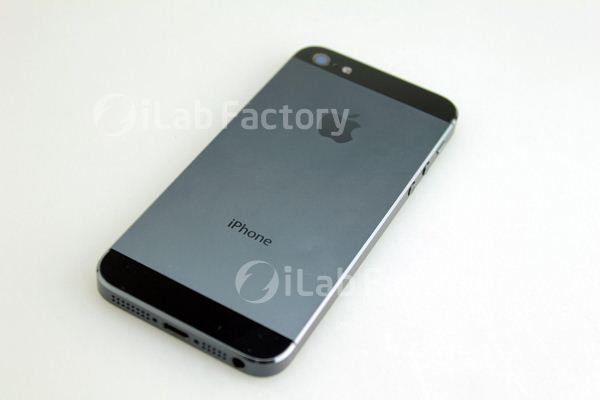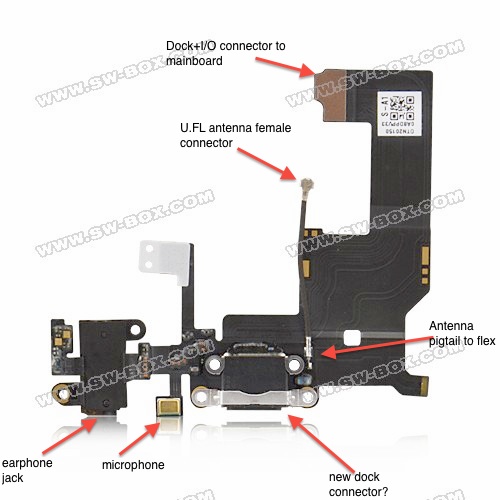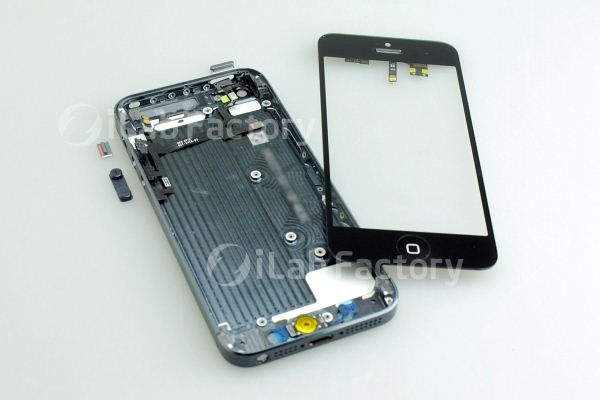Preparing for the iPhone Next: Rumors Analyzed
by Brian Klug & Anand Lal Shimpi on August 27, 2012 9:40 PM EST- Posted in
- Smartphones
- Apple
- Mobile
- iPhone
While we typically don't comment on rumors we don't know to be true at AnandTech, we often get requests to help set rational expectations ahead of major iDevice launches. The shroud of secrecy around major Apple launches can pave the way for both sensible and unrealistic conclusions.
Given the growth of Apple's iPhone/iPad devices, it has become increasingly difficult for suppliers in the chain to remain mum about any changes. Similar to how we often get early access to CPUs, motherboards and other components out of Taiwan, it has become increasingly commonplace to see leaks of iDevice components out of the big ODMs in China.
Apple is largely expected to launch its sixth iPhone next month. The historical cadence of design, SoC, and cellular changes are in the table below:
| Apple iPhone - Historical Trends | |||||||
| Release Year | Industrial Design | CPU Architecture | GPU Architecture | Cellular Architecture | |||
| iPhone | 2007 | 1st gen | ARM11 | MBX-lite | Infineon S-Gold 2 | ||
| iPhone 3G | 2008 | 2nd gen | ARM11 | MBX-lite | Infineon X-Gold 608 | ||
| iPhone 3GS | 2009 | 2nd gen | Cortex A8 | SGX-535 | Infineon X-Gold 608 | ||
| iPhone 4 | 2010 | 3rd gen | Cortex A8 | SGX-535 | Infineon X-Gold 618 in 4 GSM / Qualcomm MDM6600 in 4 CDMA | ||
| iPhone 4S | 2011 | 3rd gen | 2 x Cortex A9 | SGX-543MP2 | Qualcomm MDM6610 (MDM6600 w/ ext. trans) | ||
| iPhone Next | 2012 | ? | ? | ? | ? | ||
Trends are pretty easy to spot in the table. With the exception of the first iPhone, the industrial design appears to be on a 2-year cadence. The CPU and GPU architectures are also on the same 2-year cadence. From a silicon standpoint even the cellular architecture is trending towards the same 2-year cadence, with a few notable exceptions (e.g. GSM/CDMA iPhone 4 divide).
Based on historical trends alone it's pretty easy to conclude that we'll see a 4th generation chassis, a pair of ARM Cortex A9s and a PowerVR SGX 543MP2 under the hood. Add the assumption of LTE (a reasonable one to make) and you have a pretty believable story. It turns out the currently available evidence helps corroborate this, but let's dig through what's out there to see how this all fits.
Chassis & Display
The chassis is largely a known quantity by this point. Enough examples out of China have surfaced to support the current working theory of a 4-inch diagonal (16:9) display in a slightly taller chassis with roughly the same width. Put simply, it's a new taller aspect ratio, which also has the consequence of including a larger 4-inch, 640 x 1136 display. The result is a change only in one dimension for developers to worry about.
The other big rumored change is a move from on-cell touch sensing (which places the drive and detect ITO layers above the LCD assembly) to an in-cell touch solution. In-cell being the operative word because the drive layers are integrated into the LCD gating (or use it natively), or on the color filter layer. There's some debate about what counts as on-cell and in-cell that isn't quite settled, but ultimately what it boils down to is a thinner display stack that will contribute significantly to the reduction in overall device thickness that is rumored for the upcoming iPhone.
While the industrial design remains quite similar at a high level, there do appear to be some major changes. Where the 4 and 4S designs used front and back glass with an external metal band for support, the leaked designs out of China feature a metal unibody construction with cutouts for RF windows at top and bottom. There's enough evidence of this from the CNC machine marks visible on examples, and moreover moving to a larger form factor requires a beefier chassis.

Black regions at top and bottom are likely RF window cutouts
With top and bottom RF windows (which appear to be glass) there shouldn't be any implications on antenna performance for cellular. If you followed our coverage of the evolution of Apple's cellular antenna design from the iPhone 4 GSM, to 4 CDMA, to 4S, you'll notice that this is a clear next step, largely inheriting the top/bottom antenna split from the 4S which fully mitigated deathgrip. Interestingly enough the exterior band appears to have a different chrome finish rather than the matte stainless steel of previous designs.

Bottom flex cable, annotations ours
Other things like moving the 3.5mm headphone jack to the bottom of the device and the mini 9-pin dock connector are fairly well corroborated by leaks with components that all fit together inside the case. Interestingly enough, parts indicating the mini dock connector and relocated headphone jack have been circulating for nearly 4 months.











131 Comments
View All Comments
macs - Tuesday, August 28, 2012 - link
There goes my hope for Cortex A15... Sadtipoo - Monday, September 10, 2012 - link
Well A15 just wasn't ready yet, but I hope they do something in between like Krait.Frallan - Tuesday, August 28, 2012 - link
I understand that the focus of the writers shift and the pieces that are produced regardless of area are of the highest quality. I also understand that the site has to go where the consumers money goes.
But [RANT] I find it sad that Anandtech has become an iSite. looking back there are more and more iArticles and less and less of everything else. if this trend continues another year you will have to rebrand the site iAnandtech - allthough you probably get sued to hell and back if you did. [/RANT]
Pleas bring back the computer related articles. More GPU/CPU/SSD/HDD/SERVER and less iDevices.
BR
/F
hlovatt - Tuesday, August 28, 2012 - link
I just looked on AnandTech front page; there is exactly one Apple article, this one! That count includes the pipeline articles. For such a major player this does not seem excessive.Add to that, that Apple is a major innovator, produces original designs, introduces new technology, and retires older technology much more aggressively than other manufacturers.
Why wouldn't a tech site that looks to the future cover Apple? Would you really rather them cover Dell? We would all die of boredom!
jwcalla - Tuesday, August 28, 2012 - link
"Add to that, that Apple is a major innovator, produces original designs, introduces new technology, and retires older technology much more aggressively than other manufacturers."Were you able to write that with a straight face? If this article is anywhere near accurate, it barely brings the iPhone up to spec with year-old Android phones.
The guy has a good point: Apple rides on so much media hype that they could literally smear a turd on the touchscreen and the reviews would be glowing. Which smartphone out there has garnered a five-page article here just to cover the rumored specs?
Yeah, I get it -- "it's the iPhone". But being "the iPhone" shouldn't automatically grant it unwarranted hype, especially for a site where technical merits should be one of the highest considerations. Look at the thing objectively: spec'd out it's a rather mediocre smartphone. Would Apple's products truly be relevant without all the hype?
observerr - Tuesday, August 28, 2012 - link
I don't think you know what literally means.swb311 - Tuesday, August 28, 2012 - link
Don't get caught up by marketing. A 1GHz dual-core A5 can be every bit as fast as a newer quad core processor. A lot more goes into processor speed than pure specs. Apple custom makes their operating system AND chips so that they work together MUCH better than an off-the-shelf component like the Exynos or Krait. Just like their laptops, Apple software does more with less. So just because it doesn't look like it matches an Android phone on paper doesn't mean that it won't feel (be) faster in your hand. The fact of the matter is, as has been stated in these comments and on this blog, quad core processors are relatively useless unless software is threaded properly. Trust me, if Apple needed a quad-core processor it would put one in its phone. Android phones must distinguish themselves from EACH OTHER, hence the spec war which means almost nothing these days.alxx - Tuesday, August 28, 2012 - link
A5 (not A15) is designed to run at slower clocks and much lower power than A9KoolAidMan1 - Tuesday, August 28, 2012 - link
"it barely brings the iPhone up to spec with year-old Android phones"A new Galaxy S3 is just now competitive with an iPhone 4S, and there are still new Tegra 3 Android tablets that are outperformed by a 2011 iPad 2.
How were YOU able to write that with a straight face?
doobydoo - Wednesday, August 29, 2012 - link
Um, actually, in America, no Android manufacturers have caught up with the iPhone 4S - which still has the fastest GPU in any American smartphone. 10 months on.You're evidently simplistic method of comparing performance makes me cringe.